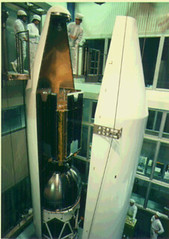
The collaboration between the Japanese and the United States in X-ray astronomy did not start with NASA. Instead, it began when a Japanese scientist (and "father" of all Japanese X-ray astronomy), Minoru Oda, visited Los Alamos National Laboratory in New Mexico in the late 1970s. At the time, ISAS was just beginning to develop an X-ray astronomy mission called Ginga.
When Oda visited Los Alamos, he talked with their scientists about collaborating on a gamma-ray burst detector. Gamma-ray bursts were mysterious bursts of gamma-rays that had been observed to occur at random across the sky. They were known to come from cosmic sources - in other words, they came from outside our Solar System - but not much beyond that was known at the time. A team of scientists at Los Alamos had made the original detection of gamma-ray bursts in the late 1960s, so it was natural to look to them as collaborators on a gamma-ray burst detector for Japan's upcoming X-ray mission.
After Oda returned to Japan, another Japanese scientist, Jun Nishimura, who had been studying gamma-ray bursts using balloon-borne experiments as well as previous Japanese satellites, joined the project as the Japanese Principle Investigator. He pursued the collaboration with the Los Alamos scientists, including Doyle Evans, Ed Fenimore, and Ray Klebesadel. In fact, Fenimore stayed in Japan to work with ISAS scientists and engineers on the project for about a year.
This marked the beginning of international collaboration for ISAS on X-ray astronomy. In addition to collaborating with the group at Los Alamos on the Ginga gamma-ray burst detector, ISAS also worked with a group at the University of Leicester in England on Ginga's main instrument, called the Large Area Proportional Counter.
Ginga launched to orbit in February 1987 and served as a valuable source for X-ray astronomy data until it re-entered the Earth's atmosphere in 1991.
A Brief History of the Collaboration
-
NASA and Japan Join Together for X-ray Astronomy: ASCA